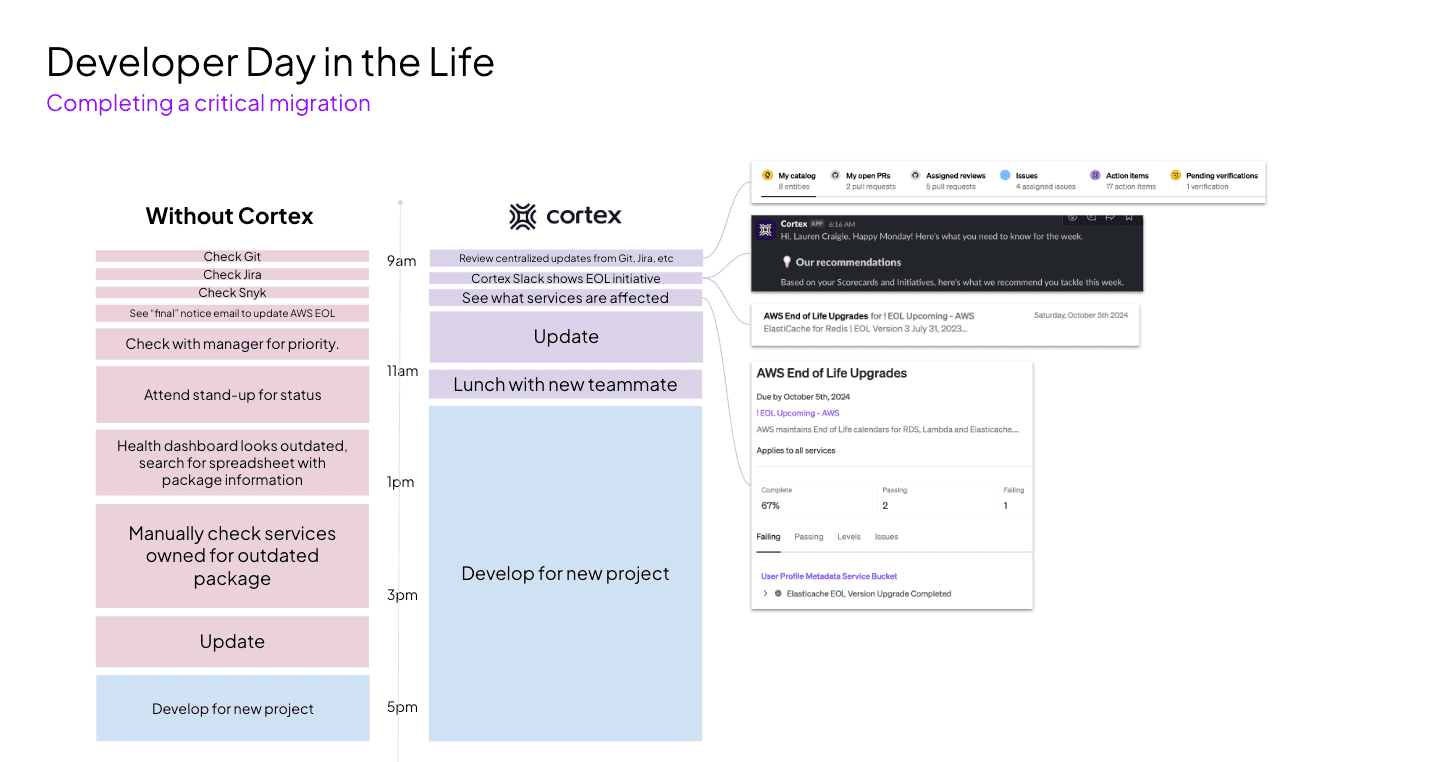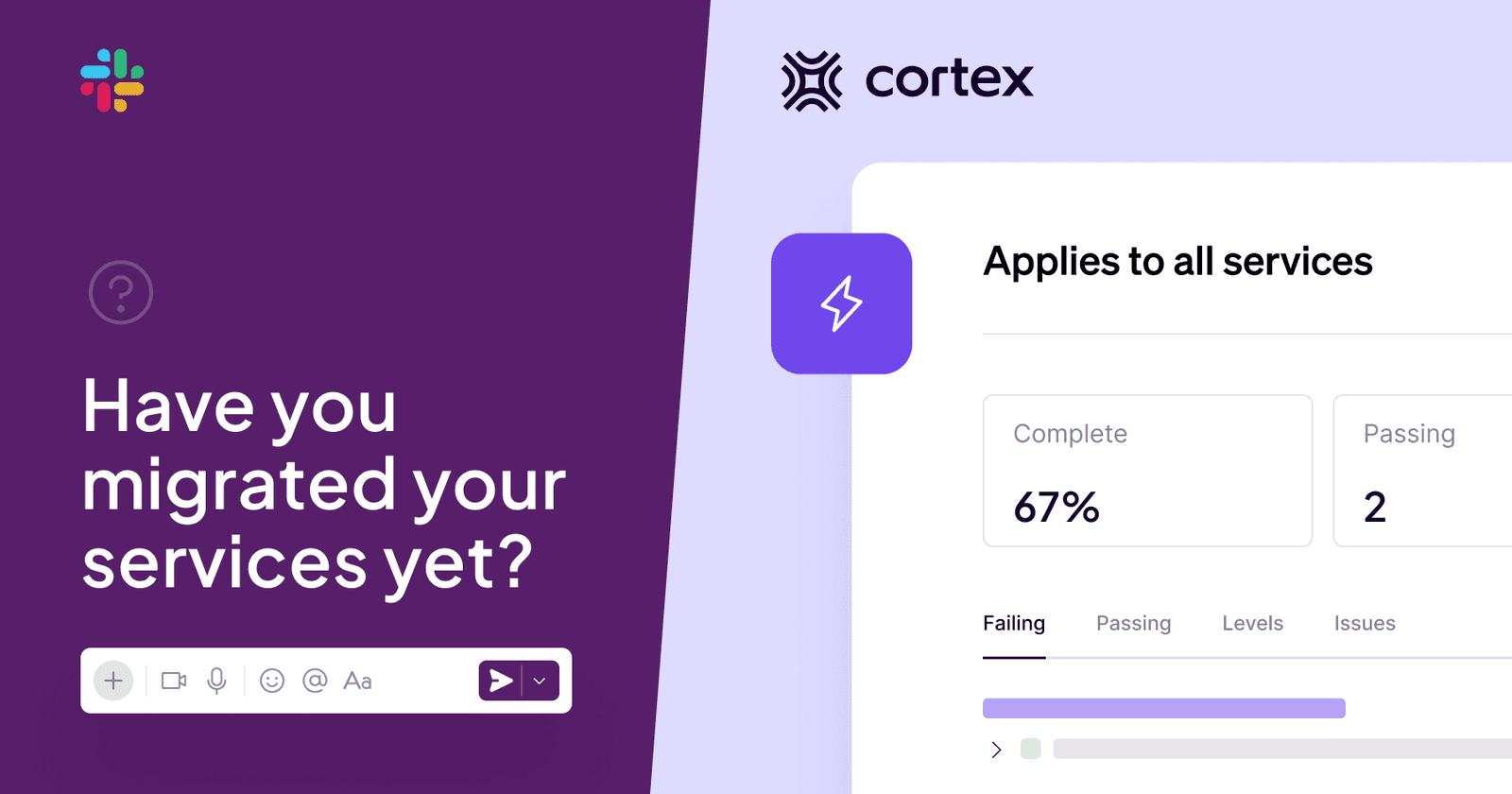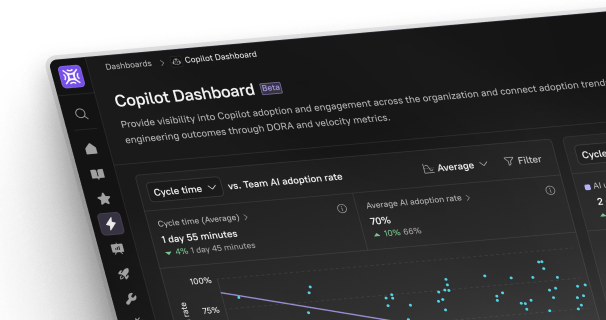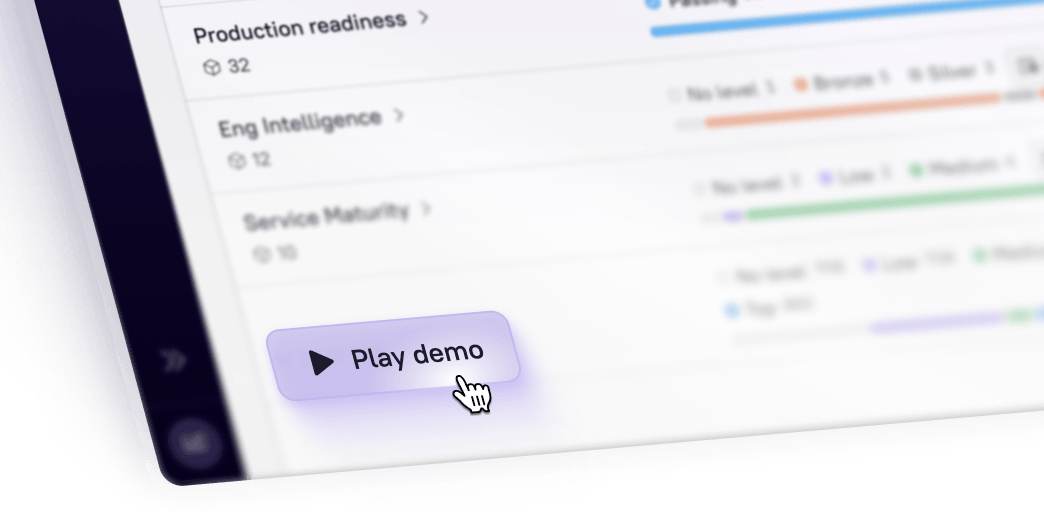Most migration/modernization/transformation—whatever you want to call these initiatives—are a pain. "Have you done x yet?" isn't something anyone wants to have to say or hear, 10x a month. But there hasn't always been a great way to drive coordinated progress on these projects—against a real deadline. Stand-ups are a productivity killer, emails go straight into the ether, and project management software is manual and self-reported.
In this blog I'll paint a probably-familiar picture of what one of these migrations might feel like today, followed by what it looks like with Cortex.
Or if you want to ditch my little story and hear from someone who's actually done it, check out our case study with LetsGetChecked who migrated their entire team to Kubernetes 8 months faster than planned, with the help of Cortex Catalogs, Scorecards, Initiatives, and Scaffolding. I won't be offended...
Migrations before Cortex
Ok. Settle in and picture Sam, a lead engineer responsible for herding cats—I mean moving their company’s legacy applications to the cloud.
Step 1: Manual inventory
Sam starts with the daunting task of inventorying all software. There’s no centralized system, so they dig through various spreadsheets, Slack threads, and outdated documentation just to identify what software exists and which teams own it. Without an auto-updating software catalog, this takes weeks.
Step 2: Manually check criteria
Once the inventory is somewhat complete, the team realizes that many applications aren’t ready for cloud migration. Sam’s team now has to manually check each application to see if it meets cloud-readiness criteria (e.g., containerized, compatible with Kubernetes, cloud-native security features). There’s no automated scoring system, so the team digs through codebases, asks around, and tries to piece together which applications need updating.
Step 3: Alert the troops
When Sam identifies apps that need action, they send out emails and Slack messages to application owners to manually request updates. Since ownership information isn’t always clear, this process involves multiple rounds of back-and-forth, waiting for replies, and clarifying migration tasks.
Step 4: Stand-ups on stand-ups
Throughout the migration, Sam struggles to track progress. There’s no real-time dashboard, so tracking which apps have been migrated, which are in progress, and which are stuck is done through endless status meetings and manual tracking. Each service migration takes weeks, and Sam’s team is constantly bottlenecked.
Step 5: Question sanity
Overall this migration has been slow, inconsistent, and a major distraction for all involved. Context switching to address pings, emails, and alerts sent indiscriminately to everyone in engineering means the costs of this migration may well outweigh any future benefit for quite some time.
Migrations after Cortex
A few months later, Cortex is implemented as an Internal Developer Portal (IDP), to unify and accelerate all engineering team initiatives. The results are night and day.
Step 1: Instant ownership clarity
Cortex provides Sam’s team with custom catalogs that match their existing business model, and provide instant visibility into all software components. With a few clicks, Sam can see every piece of software, its migration status, and the owners responsible for it. Cortex pulls data from custom data feeds or any of 60+ supported integrations like Kubernetes, AWS, and GitLab, allowing Sam to skip the weeks of manual digging and get an immediate overview.
Step 2: Live cloud-readiness Scorecards
Cortex enables Sam to create custom rules that pull from any integrated system to automatically and continually assess whether each application is ready for migration. These Scorecards check key criteria like: Is the service containerized? Does it meet cloud-native security standards (e.g., using tools like Snyk and SonarQube)? Is the infrastructure defined as code (e.g., Terraform)?
Instead of manually combing through each app, Cortex flags the ones that don’t meet the cloud requirements, saving hours of manual checks per service—for Sam, and the entire engineering team.
Step 3: Auto-identify and nudge owners for action
When Cortex detects software that isn’t cloud-ready, it automatically pings only affected owners. Cortex sends notifications via Slack, Teams, or email, providing owners with clear, actionable tasks like “containerize this service” or “update security configurations.” This eliminates Sam’s need to track down owners and follow up manually.
Step 4: Real-time progress tracking
Cortex offers real-time dashboards that allow Sam and their team to monitor migration progress at a glance. These dashboards let Sam drill down by team, domain, or individual service to show which have been successfully migrated, and which are failing rules for successful migration.
Step 5: Templates for faster deployment
Cortex provides pre-configured templates with boilerplate code for building new cloud-native services. Whether it’s creating a new microservice or refactoring a legacy app, Cortex enables teams to build cloud-ready services with best practices baked in. This standardization speeds up both new development and migration efforts, ensuring all services adhere to cloud-native principles from day one.
The results: Time and tears savings
In this scenario, Cortex helped drop migrations from months (years?) to weeks. The service catalog and scorecards eliminated the need for manual checks and reduced the coordination effort by a substantial amount. Here's what each member of the team experienced:
Manager or TPM benefit
No more manual inventory, no more project stand-ups, no more, "Have you done it yet?" emails, and certainly no more, "HEY I'M REALLY SERIOUS THIS TIME!" Slacks. Managers and TPMs get time back to focus on higher leverage projects, without feeling like the bad guy.
Developer benefit
Automated notifications meant only affected owners were pinged, and with that ping came exact instructions on what actions to take. They could act before their manager needed to come knocking, and stay focused on more important tasks. Response times improved drastically, and updates were completed faster.
Platform Engineer benefit
Instead of manually checking services and nudging owners, platform engineers could focus on optimizing infrastructure and addressing critical blockers, thanks to Cortex’s automated monitoring and tracking.
In total, Cortex cut weeks off the migration timeline and drastically reduced the workload for Sam’s team and other stakeholders. And everyone lived happily ever after.
Faster migrations with Cortex
By automating cloud-readiness checks, providing instant visibility through catalogs and dashboards, and standardizing cloud-native templates, Cortex drastically accelerated any migration initiative—be it as substantial as a cloud migration, as simple as a package upgrade, or as time-sensitive as an end-of-life notification, as in the below image.

Bottom line, Cortex eliminates hours spent chasing down owners, manually auditing software, and guessing at actual status. If your team is facing a looming migration (don't lie to me I know you have at least 3 underway right now), Cortex can help. Take the tour, or set up a custom migration demo today.





